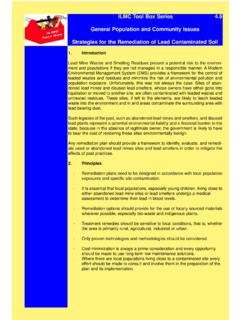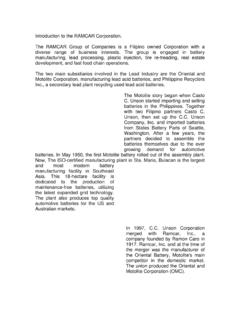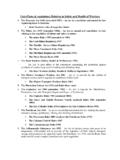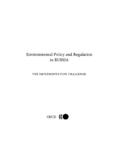Transcription of Environmental The Management Laws, Rules and Philippines ...
1 Environmental Management The laws , Rules and Regulations in the Philippines Philippines made up of 7,107 islands CLIMATE. land area of 115,739 sq. m. March to May is hot and dry. (299,764 sq. km.). June to October is rainy, Main island groups are Luzon, November to February is cool. Visayas, and Mindanao. Average temperatures: 78 F /. 25 C to 90 F / 32 C;. Capital is Manila. humidity is 77%. 1. POPULATION. There are a total of million Filipinos as of the latest national census in May, 2000. with projected population of million in 2005. Luzon, the Region III. largest island group, accounts for more than half of the entire population. DEMOGRAPHIC PROFILE. GEOGRAPHICAL COORDINATES. Longitude Latitude OF. AURORA : '80 '16. REGION III. BATAAN : '97 '48. BULACAN : '84 '90. PAMPANGA : '83 '39. TARLAC : '18 '45. ZAMBALES : '74 '06. NUEVA ECIJA : '47 '14.
2 2. POPULATION LAND AREA ( ). BULACAN - 2,234,088 NUEVA ECIJA - PAMPANGA - 1,882,730 ZAMBALES - 3, NUEVA ECIJA - 1,659,883 AURORA - 3, TARLAC - 1,068,783 TARLAC - 3, ZAMBALES - 627,802 BULACAN - 2, BATAAN - 557,659 PAMPANGA - 2, AURORA - 173,797 BATAAN - 1, TOTAL 8,204,742 TOTAL 18, Environmental Management as strategy for sustainable development requires the understanding of 3. things;. Environmental natural processes (both physical and biological ) that operate in the world Management role that technology plays in our society and its capacity to alter natural processes as well as solve problems caused by human impact complex social processes that characterize human populations 3. 1976 1987 Constitution National Pollution Control Law ( 984 ) ( Article II,Section 16 )- The State - carried out by then National Pollution should protect and advance the right Control Commission ( NPCC ) of the people to a balanced and 1978 healthful ecology in accord with the rhythm and harmony of nature Philippine Environment Management Statement ( EIS ) System ( 1586 ) 1987- Executive Order No.
3 192. - carried out by then National - Reorganization of the DENR ,NPCC, Environmental Protection Council NEPC and the Environmental ( NEPC ). Center of the Philippines - merged - EMB. MANDATE In January 2000, the EMB was converted The EMB is the primary into a line bureau from being a staff government agency under bureau of the DENR and the EMB. the Department of Regional Offices were established. Environment and Natural Resources (DENR) Section 34 of the Phil. Clean Air Act of mandated to formulate, 1999 (RA 8749) and Section 2, Rule XLIV. integrate, coordinate, of DENR AO No. 2000-81, led to the supervise and implement all policies, plans, programs, conversion of EMB into a line bureau of projects and activities the DENR. Consequently, the relative to the prevention Environmental Management and and control of pollution as Protected Areas Service (EMPAS) of the well as the Management and DENR regional office was converted into enhancement of the EMB Regional Offices in January 2000.
4 Environment. 4. GENERAL OBJECTIVE SPECIFIC OBJECTIVES. To formulate, review and update Environmental policies, programs and To properly manage and protect the projects on Environmental Management environment in order to attain and pollution control. sustainable development while To establish and enforce Environmental recognizing the primary responsibility of quality standards such as the quality local government units, non-government standards for water, air, land and noise agencies, private and business for the protection and sustainable use of organizations in dealing with natural resources consistent with the Environmental problems. national Environmental goals and enforcement at the local government units. SPECIFIC OBJECTIVES. SPECIFIC OBJECTIVES. To develop and implement Pollution To strengthen enforcement capability Research and Development Program in to handle violation of the laws , Rules , support of the ff: regulations and policies for the protection of the environment and promote the sustainable use of a.
5 Environmental criteria and standards Environmental resources. formulation Promote public information and b. Environmental monitoring and education to encourage participation compliance monitoring of an informed citizenry in c. Study of existing and potential Environmental quality planning and Environmental problems & issues monitoring. 5. SPECIFIC OBJECTIVES LEGAL FRAMEWORK. To strengthen the enforcement & Presidential Decree 984:Pollution implementation of major Environmental laws . Control Law of 1976. a. Presidential Decree 984 (Pollution Control Provides for the Revisions of RA 3931. Law) (1964) to strengthen the role of the National Pollution Control Commission b. Presidential Decree 1586 (The (NPCC) as the sole primary Agency Environmental Impact Statement System responsible for the prevention, control and Law) abatement of air, land, water & noise c.
6 Republic Act 6969 ( Toxic Substances and pollution. Hazardous and Nuclear Wastes Control Act ) Executive Order No. 192: Creating the d. Republic Act 8749 (Phil. Clean Air Act of Department of Environment and Natural 1999) Resources (DENR) [1987]. DENR is recognized as the primary e. Republic Act 9003 (Ecological Solid Waste Agency responsible for enforcing Management Act) Environmental laws . It absorbed the f. Republic Act 9275 (Phil. Clean Water Act of powers and functions of NPCC and NEPC. 2004) now discharged by the EMB. LEGAL FRAMEWORK Implementing Rules and Other Related laws to Water Quality Regulations (IRR) of PD 984. Management PD 600: Marine Pollution Law DAO 90-34: Revised water usage Establishing the National Operations and classification Water Quality Center for Oil Pollution (NOCOP) under Criteria Amending Section Nos. 68.
7 The Philippine Coast Guard (PCG) and 69, Chapter III of the 1978 NPCC. PD 1067: Water Code of the Philippines Rules and Regulations Establishing the National Water Resources Board (NWRB) DAO 90-35: Revised Effluent Adopts adequate measures to conserve Regulations of 1990, Revising and and regulate the use of water in Amending the Effluent Regulations of commercial, industrial & residential areas. 1982. Provides other policy guidelines on water quality and Management of water Ambient Noise Quality Standards resources 6. DAO # 34 Water Quality Criteria Water Usage and Classification Republic Act 9275: Fresh Surface Waters (rivers, lakes, reservoirs, etc.,) The Philippine Clean Coastal and Marine Waters Water Act of 2004. DECLARATION OF POLICIES. Salient Features Sustainable Development Framework I. Declaration of Policies Holistic National Program II.
8 Coverage Integrated WQ Framework thru proper delegation, effective coordination of III. Conceptual Framework functions IV. Water quality Management System Self regulation among industries thru'. MBIs V. Prohibited Acts; Penalties Focus on pollution prevention System of accountability of adverse VI. Funding Mechanism Environmental impacts VII. Institutional Linkages Streamline procedures and processes 7. Prohibited Acts Prohibited Acts 1. Depositing material of any kind w/c could cause water pollution 4. Non-compliance of LGU with the 2. Discharging, injecting or allowing to WQM Action Plan seep into the earth any substance that would pollute groundwater 5. Direct use of booster pumps in the distribution system or tampering 3. Operating facilities that discharge with the water supply regulated water pollutants without the valid required permits INDICATORS OF THE SOLID WASTE.
9 SITUATION IN THE Philippines . Per capita generation . kg/day M. Generated by households 10M tons/yr Annual growth rate Republic Act 9003: Toxic & hazardous wastes generated by industrial/commercial sector tons/yr 6,750 tons/yr 3,173. 73%. The Ecological Solid Hazardous & infectious wastes hospitals Collection rate: Urban 70%. 40%. Rural Waste Management Act Percentage of waste recycled & reused 12%. Percentage of waste recycled & sold 5%. of 2000 No. of disposal sites: Landfills Closed landfills 1. 2. Controlled dumps 17. Industrial waste incinerators 13 5. Identified open dumps 226. Identified composting facilities 31. Identified recycling facilities 10. 8. INDICATORS OF THE SOLID WASTE FACTORS THAT CONTRIBUTE TO THE. SITUATION IN THE Philippines SOLID WASTE PROBLEM. INDICATOR NATIONAL METRO SPIRALLING POLUTION RAPID. GROWTH RATES URBANIZATION.
10 MLA. No. of hospitals 18,500. No. of hospital waste incinerators 43 22. No. of hazardous waste treatment facilities 28. Percentage of municipal solid waste disposed in landfills & controlled dumps 2%. MUNICIPAL. Percentage of waste composted 10% SOLID WASTE. Percentage of hospitals w/access to 50%. incinerators Percentage of hazardous waste treated or 5% PUBLIC CHANGING. INDIFFERENCE LIFESTYLE. recycled Percentage of LGU budget allotted to solid 1-2%. waste Management CONSUMPTION. PATTENRS. PRINCIPLES OF SOLID PRINCIPLES OF SOLID. WASTE Management WASTE Management . who generate waste must bear the 1. Waste is a resource. cost of its Management and disposal. prevention is better than waste 6. Solid waste Management should be regulation control. approached within the context of resource integrated solid waste conservation, Environmental protection Management system will best achieve and health, and sustainable development.








